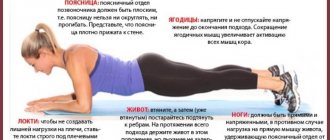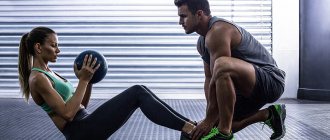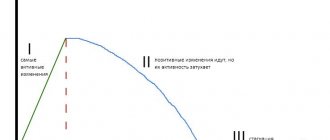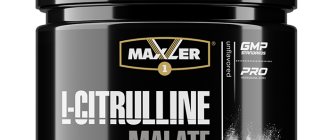Causes of pain when extending the arm after exercise
There are several reasons why your arm hurts after training. And they depend on the level of training:
- For beginners
In 90% of cases, this is a banal overstrain of the lower biceps ligament, which is attached to the radius bone of the forearm. The reason is excessive enthusiasm.
Beginners pump their biceps hard during their first workouts in the hope that they will instantly grow. At the same time, they perform a large number of exercises and approaches for this small muscle group, which does not correspond to the level of training.
As a result, instead of growth, they get inflammation of the ligaments and the inability to straighten their arms the next day.
The remaining 10% of cases are injuries to the elbow ligaments. This is already serious. But fortunately for beginners, it is quite rare among them.
But for experienced athletes, this type of pain is already commonplace.
- For experienced athletes
Advanced athletes know their body and the required level of training load.
But sometimes, in a fit of sports passion, they too increase the working weights or the volume of training load on the biceps.
At best, this leads to harmless but severe soreness in the biceps. At worst, it can lead to serious inflammation and tears of the ligaments of both the biceps muscle itself and the ligaments of the elbow joint (collateral and annular).
The problem is that in the first day or two after training it is difficult to distinguish between sore throat and injury due to similar pain symptoms.
What to do
So we have established the causes of pain in the arms after exercise. This is a severe soreness of the biceps, inflammation (strain) of the biceps ligament or injury to the elbow ligaments.
If you have severe acute pain in the elbow joint, which worsens with the slightest flexion and extension of the arm, and there is swelling and redness (in severe cases, hematoma) of the injured area, most likely this is a ligament injury.
In this case, it is necessary to urgently consult a traumatologist for diagnosis and prescribing a course of treatment.
If the pain allows you to move your arms, albeit with difficulty and discomfort, then we are most likely talking about severe sore throat or inflammation of the ligaments. This problem can be dealt with even at home.
Usually, severe soreness in the biceps goes away on its own within 3-5 days. If inflammation of the ligaments occurs, complete rehabilitation takes from 7 to 14 days.
This process can be accelerated if you perform a number of recovery procedures, which we will discuss further.
Types of damage
- Tendon ruptures and avulsions
Injuries to the flexors and extensors of the fingers are accompanied by a violation of their integrity due to direct or indirect impact. If damaged, a rupture and complete separation of the tendon from its attachment to the bone fragment is possible.Qualification of injuries:
- Open and closed - depending on the violation of the integrity of the skin
- Fresh, stale and old - depending on how old the injury is
- Combined, isolated, and multiple - depending on the number of affected areas
Partial and complete - depending on the degree of damage
- Tenosynovitis of the hand is an acute or chronic inflammation that occurs in the synovial membranes of the fibrous sheaths of the tendons of the muscles of the hand and fingers. Tenosynovitis is accompanied by a crunching sound when moving, a slight swelling along the affected tendon sheath
Treatment of inflammation and sprains at home
Here are step-by-step instructions for quick rehabilitation of inflamed ligaments (or mild sprains) when your arms cannot be straightened:
- The first step is to apply cold to the problem area.
This can be any item from the refrigerator if there is no ice on hand.
The purpose of a cold compress is to relieve swelling and prevent inflammation. The duration of the procedure is 15-30 minutes.
- The next step is taking non-steroidal anti-inflammatory drugs and ointments
The working ligament is a Nimesil sachet and Diclofenac ointment. These drugs have analgesic, anti-inflammatory and analgesic effects.
“Nimesil” is taken 2-3 sachets per day. Usually 2-3 days of use are enough to significantly reduce pain.
Diclofenac ointment is rubbed into problem areas 2-3 times a day for 5-7 days. Even if you no longer feel pain in the ligaments, this does not mean that everything is fine.
Residual inflammatory processes last for several more days. Therefore, to avoid recurrence of the injury, it is advisable to use the ointment for another 2-4 days after the end of the pain syndrome.
If you simply have severe soreness the day after training, and your arms do not bend or straighten, physiotherapy and ointments with a warming effect will come to the rescue.
The most effective and quick way to relieve soreness is a bath or sauna, a warm bath, massage or self-massage, and light stretching. The essence of all these procedures is to increase blood flow to the hypertensive area.
For the same purpose, various warming ointments are used. Apizartron ointment, which contains bee venom, has proven to be very effective in sports.
The hardest thing (especially for beginners) is to correctly determine the cause of pain in the hands. And if everything is more or less clear with a serious injury, then sore throat and inflammation of the ligaments are often confused.
The fact is that if the ligaments are sprained and inflamed, the injured area should not be exposed to heat for the first 1-2 days. Only cold and anti-inflammatory drugs. You can warm them up from 3-4 days.
But with sore throat, warming procedures begin from the first day of pain.
If you doubt the nature of the origin of the pain, then take anti-inflammatory drugs and ointments for the first day or two.
If the unpleasant sensations have sharply decreased in a couple of days, it means that it was a sore throat (the ligaments hurt a little longer and the pain goes away smoothly, gradually), and you can use warming ointments.
Tendon rupture - symptoms and treatment
Treatment of injuries to the tendons of the hand, especially the flexors, is one of the most difficult sections of surgery. It is most difficult to restore the function of tendons when they are damaged in the area of the tendon sheaths of the fingers (from the distal palmar fold to the nail phalanx) and along the carpal tunnel (that is, zones I, II and IV).
Currently, when treating patients with tendon injuries, surgical treatment is considered the method of choice.
Recovery of the flexor tendons depends on the level of damage. A large number of methods for their restoration have been proposed: Cuneo sutures, removable suture according to S. Bunnell, Rozov sutures, Tsuge suture, etc. The problem of unsuccessful treatment of the primary suture of the flexor tendons has become so acute that the founder of modern hand surgery, the American surgeon S. Bunnell in 1944 called zone of tendon damage in the area of bone-fibrous canals “no man’s land” [13]. However, since the 90s of the last century, an operation with a primary tendon suture at the level of the osteofibrous canals is considered “preferred”. Unfortunately, surgeons encounter specific complications after surgery: wound suppuration, tendon suture failure, tendon fusion with surrounding tissues, and finger contracture (limited joint mobility).
There are many classifications of applied tendon sutures . They are divided into submersible and removable, extra-barrel and intra-barrel, side-by-side and end-to-end seams [13]. In addition, sutures are divided into interrupted, ligature (applied with surgical thread), U-shaped, cruciform (Cuneo, Bunnell), loop-shaped (Tsuge, Rozov, Kessler).
General requirements for tendon suture:
- The seam should be simple and easy to make.
- The suture should disrupt the blood supply as little as possible, for which purpose a minimum number of tendon bundles are captured in the nodes and loops of the suture.
- The seam should provide a smooth surface, so there should be a minimum of threads on the surface of the tendon.
- The seam must be strong and not disintegrate the tendon.
- The number of knots on the seam should be minimal.
- Adaptation of tendon ends must be anatomical.
- The suture should hold the tendon ends tightly adjacent to one another, without leaving the cut surface exposed.
- The suture assembly should not be located on the surface of the tendon.
In case of damage to the shoulder flexor tendon, all methods of surgical treatment can be divided into two large groups:
- Methods for restoring the integrity of the biceps brachii muscle without tendon plastic surgery.
- Methods using tendon plastics.
During surgical treatment, there are two ways to attach the tendon:
- connection of tendons with the place of natural attachment (reinsertion);
- connection of tendons with a newly chosen place of attachment (transplantation methods) [1].
When the long head of the biceps muscle is ruptured, the distal (far) end of the torn tendon is fixed to the subtubercular region with a transosseous (transosseous suture) using the methods of V.F. Trubnikov, KO Haldeman, R. Soto-Hall or the method of open tenodesis according to Post (an operation aimed at restriction of a certain type of movement in the joint) [6].
If the tendon ruptures at the junction with the muscle belly, autoplasty is performed. Its essence is as follows:
- The proximal (closer to the center) and distal (further from the center) ends of the tendon are distinguished.
- The muscle belly of the long head of the biceps brachii muscle is freed from adhesions and cicatricial adhesions and pulled up as much as possible.
- From the selected distal fragment, one U-shaped flap on a feeding pedicle is cut out for the entire length. The base of this flap should not extend beyond the rupture site by 1 cm.
- The mobilized ends of the tendon are refreshed (the crushed edges are cut off), after which sutures are placed on them. To do this, the ends of the tendon are brought together and compared, and then fixed in this position using a tendon suture. As a result, the length of the tendon and the physiological tension of the muscle are restored.
- The cut autograft is turned 180 degrees and placed on the tendon suture with the sliding surface facing outward. After this, it is fixed to the restored tendon [1].
When the distal biceps tendon ruptures, its reinsertion (re-transplantation) using the Boyd-Anderson method from two incisions is popular.
During the operation:
- A small transverse incision is made in front of the elbow joint and a longer incision is made along the radial side of the edge of the elbow behind.
- The deep fascia of the shoulder is opened in front and the biceps tendon is isolated.
- A natural tunnel in the interosseous membrane of the forearm is determined.
- Apply wrapping sutures according to Krackow to the end of the damaged tendon.
- Using a long, curved hemostat, the tendon is moved from the anterior to the posterolateral incision.
- A “groove” is made in the tuberosity of the radial bone using an osteotome or an oscillating saw. Two holes are drilled in the dorsal part of the recess, leaving a bone bridge 10 mm wide between them.
- The threads with the tied tendon are passed through the interosseous membrane.
- The ends of the threads are passed through the holes made, tightening and fixing the tendon in the recess in the bone.
In addition to traditional open surgical methods, there is a minimally invasive alternative in the form of atroscopic tendon tenodesis, or tendon tenodesis through a mini-approach. Minimally invasive methods of surgery are attractive due to the faster recovery of the patient in the postoperative period due to less tissue trauma during surgery, as well as a better cosmetic effect.
In the postoperative period, the operated limb requires mandatory fixation for 5-6 weeks. This can be either the usual plaster thoracobrachial bandage or a plaster splint according to Turner, or all types of modern fixators in the form of bandages and orthoses. The choice of type of fixation depends on the initial state of the torn tendon and the presence of previous degenerative changes in it.
Prevention
It is known that prevention of any disease is easier than its treatment. The same rule applies to the gym.
It is better to take precautions to reduce the risk of injury than to heroically fight this very injury later.
Methods for preventing injuries during power loads include:
- General warm-up before the main part
This includes walking, running, cycling, joint warm-up and light dynamic stretching. Duration - 5-10 minutes.
- Special warm-up
Performed before strength exercise.
Before you begin working weights, be sure to perform a warm-up approach with light weights and a high number of repetitions (40-50% of the repetition maximum).
- Maintaining the correct technique for performing the exercise
If the technique is broken and you are not able to control it, then this weight is not suitable for you. It is necessary to reduce the weight of the burden.
- Avoiding heavy weight exercises if you feel very tired or unwell
- Post-workout cool-down (light cardio and stretching of the muscles being trained)
- It is possible to carry out physical procedures on days off from training that speed up recovery - baths, massages, etc.
How to get rid of painful sensations
Professionals always use elbow pads when performing exercises. If your elbows hurt after training, then you need to purchase soft elastic bandages for exercise. When worn, they do not limit the range of movement, but prevent the occurrence of excess loads. When doing bodybuilding, it is better to use neoprene elbow pads, which provide good shock absorption to the joints. They are especially relevant for bench presses with heavy weights.
You can't do without elbow pads during training.
Any elbow pads warm up the elbows, stimulate increased blood circulation, reducing the likelihood of lactic acid accumulation in the muscles. What else do sports doctors recommend:
- use of warming ointments, for example, Ben-Gay. The drug can be applied under elbow pads, but only those made from natural materials. It is not advisable to purchase ointments with a high content of red pepper or snake venom;
- adjusting the height of the racks. When bench presses, the elbow joints receive maximum traumatic stress. Therefore, when removing the hyphae from the stands, it is necessary to fully straighten your arms. If there is noticeable pain, you need to ask the trainer to remove the barbell;
- regulation of training intensity. Chronic elbow injury is almost always the result of overuse. If you exercise too intensely and frequently, you will not only not be able to get rid of the pain, but its severity will increase significantly due to regular microtrauma of the tissues;
- no dangerous combinations. Often, beginners neglect the trainer’s recommendations and perform exercises arbitrarily, which can cause serious injury. The constant presence of a trainer in the gym monitoring the technique will help avoid traumatic situations.
When your elbow still hurts after training, despite the preventive measures taken, you can use a cold compress. A cloth moistened with cold water is applied to the joint, or ointments with a cooling effect are applied. They usually contain menthol, levomenthol, and mint oil.
A cold compress works well to relieve swelling and redness of the elbow.
If you have to take analgesics to relieve pain, then an inflammatory or degenerative process develops in the elbow joint. In such cases, you cannot do without the help of a doctor.











